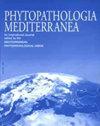中国7种猕猴桃地上部枯萎病和叶斑病双孢菌的生物学和分子特征
IF 1.9
3区 农林科学
Q2 AGRONOMY
引用次数: 4
摘要
Diaporthe物种是重要的病原体、腐菌和内生菌,具有全面的宿主关联和地理分布。这些真菌会导致不同植物寄主上果实的严重枯死、溃疡、叶斑、枯萎和茎端腐烂。本研究探讨了我国猕猴桃主产区与中华猕猴桃和美味猕猴桃相关的双孢菌的发生、多样性和致病性。对来自106个病叶和病枝样品的Diaporthe分离株(284)进行了检测。对43个具有代表性的分离株进行了多点系统发育分析和形态学分析,共获得7个双孢菌种,分别为A.langii、D.compactum、D.eres、D.hongkongensis、D.sojae、D.structoae和D.unshuensis。对猕猴桃果实、叶片和枝条进行了致病性试验。Koch的假设证实了所有物种都具有致病性。A.langii和D.constructaae是最具攻击性的物种,其次是D.eres、D.sojae、D.hongkongensis、D.unshuiensis和D.compactum。寄主范围评价表明,7个双孢菌种也能感染杏、苹果、桃、梨和李。这是A.langii、D.compactum、D.sojae、D.structoae和D.unshuuensis在中国首次感染猕猴桃的报道,增加了对引起猕猴桃植物疾病的Diaporthe复合体的了解,以帮助有效的疾病管理。本文章由计算机程序翻译,如有差异,请以英文原文为准。
Biological and molecular characterization of seven Diaporthe species associated with kiwifruit shoot blight and leaf spot in China
Diaporthe species are significant pathogens, saprobes, and endophytes, with comprehensive host association and geographic distribution. These fungi cause severe dieback, cankers, leaf spots, blights, and stem-end rot of fruits on different plant hosts. This study, explored the occurrence, diversity and pathogenicity of Diaporthe spp. associated with Actinidia chinensis and A. deliciosa in the main kiwifruit production areas of China. Diaporthe isolates (284) derived from 106 diseased leaf and branch samples were examined. Multi-locus phylogenetic analyses and morphology of 43 representative isolates revealed that seven Diaporthe species were obtained, including D. alangii, D. compactum, D. eres, D. hongkongensis, D. sojae, D. tectonae, and D. unshiuensis. Pathogenicity tests were performed on kiwifruit fruits, leaves and branches. Koch’s postulates confirmed all species were pathogenic. D. alangii and D. tectonae were the most aggressive species, followed by D. eres, D. sojae, D. hongkongensis, D. unshiuensis, and D. compactum. Host range evaluation showed that the seven Diaporthe species could also infect apricot, apple, peach, pear, and plum. This is the first report of D. alangii, D. compactum, D. sojae, D. tectonae, and D. unshiuensis infecting kiwifruit in China, increasing understanding of the Diaporthe complex causing diseases of kiwifruit plants, to assist effective disease management.
求助全文
通过发布文献求助,成功后即可免费获取论文全文。
去求助
来源期刊

Phytopathologia Mediterranea
生物-植物科学
CiteScore
4.40
自引率
8.30%
发文量
28
审稿时长
6-12 weeks
期刊介绍:
Phytopathologia Mediterranea is an international journal edited by the Mediterranean Phytopathological Union. The journal’s mission is the promotion of plant health for Mediterranean crops, climate and regions, safe food production, and the transfer of new knowledge on plant diseases and their sustainable management.
The journal deals with all areas of plant pathology, including etiology, epidemiology, disease control, biochemical and physiological aspects, and utilization of molecular technologies. All types of plant pathogens are covered, including fungi, oomycetes, nematodes, protozoa, bacteria, phytoplasmas, viruses, and viroids. The journal also gives a special attention to research on mycotoxins, biological and integrated management of plant diseases, and the use of natural substances in disease and weed control. The journal focuses on pathology of Mediterranean crops grown throughout the world.
The Editorial Board of Phytopathologia Mediterranea has recently been reorganised, under two Editors-in-Chief and with an increased number of editors.
 求助内容:
求助内容: 应助结果提醒方式:
应助结果提醒方式:


